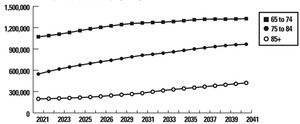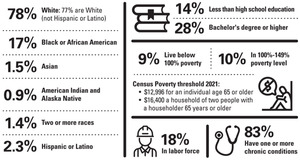North Carolina ranks ninth nationally in population aged 65 and older and has undergone significant demographic changes in the 21st century.1 Assessing and understanding the demographic changes and their implications will be critical in addressing age-related issues, catalyzing change, and preparing for the future of North Carolina.
North Carolina is home to 1.8 million adults aged 65 and over, representing 17% of the total population of the state.2 In 2021, 1 in 6 people in North Carolina were aged 65 and over, and by 2031, there will be more people aged 65 and over than children under 18 in the state.2 According to the North Carolina State Center for Health Statistics, if age-specific mortality remains unchanged, North Carolinians aged 65 and over are expected to live, on average, an additional 19 years.3 Some key factors reshaping and increasing North Carolina’s older population include the aging Baby Boomer population, increasing average life expectancy over time, declining fertility, and migration of people from other states and abroad.4 By the year 2030, all Baby Boomers will be between the ages of 66 and 842 (Figure 1).
Age Cohorts
Of the population aged 65 and over, the “young old” (ages 65–74) and the “older old” (ages 75–84) represent 89% of the state’s older adults.2 Research has shown that how older adults perceive their age can differ from their chronological age by 10–20 years; many older adults now feel much younger physically and mentally than their previous cohorts.5 Meanwhile, the “oldest-old” demographic (ages 85+), which makes up only 2% of the total population, is projected to have the highest growth—116%—in the next two decades, as the Baby Boomers continue to age2 (Figure 2). The younger older adults are more likely to be healthy and active while the growth of the oldest-old population aged 85 and over may create a higher need for long-term supports and services.
Assessing the needs of the aging population requires a closer look at geographic distribution, gender and racial composition, socioeconomic characteristics, and health status factors.
Geographic Distribution
The state’s 70 rural counties contain 38% of the 65-and-over population.2 Future projections of the aging population in the next decades indicate that not all counties in the state will experience growth at the same rate, as more older adults concentrate in certain geographic areas.2 While some counties, like Mecklenburg and Wake, will see rapid growth in expanding parts of metropolitan areas, others will experience moderate growth, and many rural counties will experience a decline in the older adult population.2 According to Dr. Michael Cline, North Carolina state demographer, the state will see tremendous growth in older adult population in major urban areas as a function of aging in place and migration, as people seek areas with amenities like health care or proximity to family (personal communication from Michael Cline, state demographer, North Carolina Office of State Budget and Management, January 26, 2023). In contrast to urban counties, older adults living in rural counties are more likely to be African American; have higher poverty and disability rates; are less educated; and face challenges with transportation, housing, food insecurity, access to health care, and availability of broadband services.6,7
Gender Profiles
The older North Carolinian population is disproportionately female. Although women represent 56% of the 65-and-over age group, this gender composition widens toward the oldest-old age, as women have a higher life expectancy and tend to outlive their male counterparts.5,8 In 2021, 43% of the households in North Carolina had a single occupant aged 65 and over, and of the nearly half a million people aged 65 and over living alone, 69% of them were women.9 Women often live alone and are at higher risk of poverty and social isolation in their older age—among the population aged 65 and over, an estimated 46% of women are married, compared to 71% of men.10 It is also important to recognize the unique disparities and discrimination experienced among lesbian, gay, bisexual, or transgender (LGBT) older adults.11
Racial/Ethnic Profiles
Although North Carolina’s older adult population continues to be predominantly 77% White (non-Hispanic or Latino), the state is continuing to grow more ethnically and racially diverse.9 In 2021, 23% of people aged 65 and older were members of racial or ethnic minority populations—17% were African American, 1.5% were Asian, 0.9% were American Indian or Alaskan Native, and 1.4% identified themselves as being of two or more races.9 People of Hispanic origin (who may be of any race) represented 2.3% of the older population, and their proportion will only continue to grow in the future.9 The foreign-born population represented 5% of North Carolina’s older adults; moreover, North Carolina will continue to become more diverse as more people migrate into the state from other countries.9,12
Socioeconomic Characteristics: Education, Income, and Employment
According to Healthy People 2030, people with higher levels of education—a major component of socioeconomic status—are more likely to be healthier and live longer, and people with steady employment are less likely to live in poverty and more likely to be healthy.13 An estimated 86% of adults aged 65 and over have a high school education or higher, with 28% holding a bachelor’s degree or higher9 (Figure 3). Adults aged 65 and over who are legal residents of North Carolina interested in going back to school, engaging in continuous education opportunities, or gaining additional skills can take courses at community colleges. With the growing aging population, colleges are now recruiting more adult learners with complex needs and differing backgrounds, reframing the image that comes to mind when people think about college students. According to the North Carolina Community College System (NCCCS), 3% of enrollment by age range was represented by adults aged 65 and over and 17% by those aged 45–65 in 2021–2022.14 Increasing educational and workforce opportunities for older adults in our community is integral to improving overall quality of life, productivity, and engagement, as research indicates that education can positively impact aging.15
Moreover, the median household income of householders aged 65 and over in 2021 was $45,261.16 An estimated 92% of them received income from Social Security and 54% from retirement income.9 In 2021, nearly 1 in 10 people aged 65 and over lived below the poverty level; another 10% were classified as “near poor” (income between the poverty level range of 100%–149%).9 However, adults aged 65 and over experience lower poverty rates in comparison to other age groups due to federal programs such as Medicare and Social Security, which play a critical role in enhancing economic security.
Currently, adults aged 65 and over constitute 3.2% of the state’s labor force; when looking at just the aged 65 and over population, 18% are in the labor force.9 While our aging population presents economic concerns with participation in workforce declining, many older adults choose to continue working for a variety of reasons, including sense of purpose, a desire to be engaged, financial responsibilities, and living longer and healthier lives.16 Phased retirement programs, flexible schedules with part-time work/telecommuting, ongoing training to master new skills, the Senior Community Service Employment Program (SCSEP), and other strategies that present options to work beyond traditional retirement are keeping more older adults in the workforce.16 Additionally, many older adults continue to stay involved through civic engagement/volunteering opportunities. These opportunities offer various health benefits: decrease in anxiety and depression, decrease in loneliness and social isolation, enhanced physical activity, and higher life satisfaction.16
Health Status
Of the population aged 65 and over, 83% have one or more chronic diseases, and 1 in 5 people report trouble walking.17,18 Despite aging increasing the risk of chronic conditions that affect independence and quality of life, 72% report involvement in exercise activities.19 Several evidence-based health promotion and disease-prevention programs promote healthy aging and help prevent the progression of existing chronic conditions or delay the onset of new chronic conditions. While health status can be affected by socioeconomic factors, it is also affected by individual behaviors. Regular physical activity can help older adults stay active and socially engaged while preventing many health problems.20
Unprecedented Growth in Aging Presents Opportunities and Challenges
In summary, North Carolina has a growing, economically and ethnically diverse aging population that requires the state’s resources, partnerships, and human services to be prepared for the coming demographic shifts. The unprecedented growth of the aging demographic brings challenges to long-term services and supports, particularly when it comes to meeting the needs of a diverse aging population, identifying and funding effective programs that provide high returns on investments, improving outcomes, and preparing for the increasing incidences of chronic conditions and comorbidities with a shortage of health care professionals and resources. However, the situation also presents opportunities and positive developments, such as increasing workforce and civic engagement participation, raising the priority of supporting aging, promoting socioeconomic equity, designing age-friendly communities, advocating for successful aging-in-place models, implementing multidisciplinary approaches in health care systems, and redesigning services.
Disclosure of interests
The authors have no conflicts of interest.
Acknowledgments
We acknowledge Michael Cline and Allison Eargle for their contributions.






